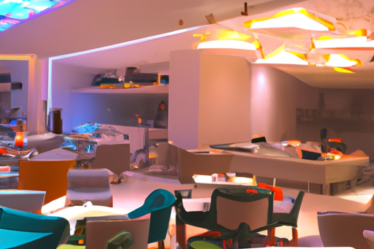
The Role of Virtual Reality in Enhancing Empathy in Cultural Tourism
The Rising Importance of Empathy and New Technology in Culture & Heritage Tourism
In recent years, there has been a growing recognition of the importance of empathy in culture and heritage tourism. As travelers seek more meaningful and authentic experiences, the ability to connect with the local culture and history becomes paramount. This is where new technologies, such as virtual reality (VR), have emerged as powerful tools in enhancing empathy and enriching the tourism experience.
Virtual reality, once seen as a futuristic concept, has now become increasingly accessible to the general public. With the help of VR headsets, users can be transported to different places and times, immersing themselves in the sights and sounds of a particular culture or historical period. This technology has the potential to revolutionize the way we experience and understand cultural heritage.
One of the key advantages of virtual reality in cultural tourism is its ability to create a sense of presence. By simulating a realistic environment, VR allows users to feel as if they are physically present in a different time or place. This sense of presence can greatly enhance empathy by enabling users to see the world through the eyes of others. For example, VR can transport users to a war-torn city, allowing them to witness the devastation and understand the experiences of those who lived through it.
Moreover, virtual reality can also provide a more inclusive experience for individuals with physical disabilities. By removing physical barriers, VR allows everyone to explore cultural heritage sites and participate in activities that may have been previously inaccessible. This inclusivity not only benefits individuals with disabilities but also promotes a more diverse and inclusive tourism industry.
In addition to enhancing empathy, virtual reality can also serve as a valuable educational tool. By providing interactive and immersive experiences, VR can help visitors gain a deeper understanding of cultural heritage. For instance, users can virtually explore ancient ruins, interact with historical figures, or participate in traditional ceremonies. This hands-on approach to learning can be particularly effective in engaging younger generations and fostering a sense of curiosity and appreciation for different cultures.
Furthermore, virtual reality can also play a role in preserving cultural heritage. By creating digital replicas of endangered sites or artifacts, VR can help safeguard cultural treasures for future generations. This technology can also facilitate the sharing of cultural knowledge and traditions, allowing communities to preserve and transmit their heritage in a more accessible and engaging manner.
While virtual reality holds great potential in enhancing empathy and enriching cultural tourism, it is important to acknowledge its limitations. VR experiences, no matter how immersive, can never fully replicate the complexity and nuances of real-life interactions. Therefore, it is crucial to strike a balance between using technology as a tool to enhance empathy and ensuring that it does not replace genuine human connections and experiences.
In conclusion, the rising importance of empathy in culture and heritage tourism has paved the way for the integration of new technologies, such as virtual reality. By creating a sense of presence and providing inclusive and educational experiences, VR has the potential to revolutionize the way we engage with cultural heritage. However, it is essential to approach these technologies with caution and ensure that they complement, rather than replace, genuine human interactions. With the right balance, virtual reality can truly enhance empathy and enrich the cultural tourism experience for all.
How Augmented Reality is Revolutionizing the Cultural Heritage Experience

The Rising Importance of Empathy and New Technology in Culture & Heritage Tourism
How Augmented Reality is Revolutionizing the Cultural Heritage Experience
In recent years, there has been a growing recognition of the importance of empathy in culture and heritage tourism. Travelers are no longer satisfied with simply visiting historical sites and museums; they want to truly connect with the past and understand the experiences of those who came before them. This shift in mindset has led to the rise of new technologies, such as augmented reality, that are revolutionizing the cultural heritage experience.
Augmented reality (AR) is a technology that overlays digital information onto the real world, enhancing the user’s perception and interaction with their surroundings. In the context of culture and heritage tourism, AR allows visitors to immerse themselves in the past and gain a deeper understanding of historical events and cultural traditions.
One of the key advantages of AR is its ability to bring historical artifacts and sites to life. Instead of simply reading about a historical event or looking at a static display, visitors can use AR to see how things would have looked in the past. For example, they can use their smartphones or AR glasses to view a virtual reconstruction of an ancient city or watch a reenactment of a historical event. This not only makes the experience more engaging and interactive but also helps visitors develop a greater sense of empathy for the people who lived in that time period.
AR also allows visitors to personalize their cultural heritage experience. With AR apps, they can choose their own path and explore the aspects of history and culture that interest them the most. For example, they can follow a specific character’s story or focus on a particular period in history. This level of customization not only makes the experience more enjoyable but also helps visitors develop a deeper connection with the past.
Furthermore, AR can help bridge the gap between different cultures and languages. With AR translation features, visitors can easily understand the information presented at cultural heritage sites, regardless of their native language. This not only makes the experience more inclusive but also fosters a sense of global understanding and appreciation for different cultures.
In addition to enhancing the visitor experience, AR also offers numerous benefits for cultural heritage organizations. By incorporating AR into their exhibits and tours, these organizations can attract a wider audience and increase visitor engagement. AR can also provide valuable data and insights about visitor behavior, allowing organizations to tailor their offerings to better meet the needs and interests of their audience.
However, it is important to note that while AR has the potential to revolutionize the cultural heritage experience, it should not replace traditional forms of interpretation. The human element, such as knowledgeable guides and experts, is still crucial in providing context and facilitating meaningful connections with the past. AR should be seen as a complementary tool that enhances the visitor experience, rather than a replacement for human interaction.
In conclusion, the rising importance of empathy in culture and heritage tourism has led to the development of new technologies, such as augmented reality, that are revolutionizing the cultural heritage experience. AR allows visitors to immerse themselves in the past, personalize their experience, and bridge the gap between different cultures. It also offers numerous benefits for cultural heritage organizations. However, it is important to strike a balance between technology and human interaction to ensure a meaningful and engaging cultural heritage experience.
The Impact of Artificial Intelligence on Empathetic Cultural Tourism Experiences
The Impact of Artificial Intelligence on Empathetic Cultural Tourism Experiences
In recent years, the tourism industry has witnessed a significant shift towards more empathetic and immersive experiences. Travelers are no longer satisfied with simply visiting famous landmarks or museums; they want to connect with the local culture and heritage on a deeper level. This growing demand has led to the integration of new technologies, such as artificial intelligence (AI), into cultural tourism experiences.
AI has the potential to revolutionize the way we experience and understand different cultures. By leveraging AI, cultural tourism destinations can offer personalized and interactive experiences that cater to the unique interests and preferences of each visitor. This technology allows for the creation of virtual tour guides, chatbots, and interactive exhibits that enhance the visitor’s understanding and appreciation of the local culture.
One of the most significant impacts of AI on cultural tourism is the ability to create virtual tour guides. These AI-powered guides can provide visitors with real-time information, historical context, and interesting anecdotes about the cultural sites they are visiting. By using natural language processing and machine learning algorithms, these virtual guides can engage in conversations with visitors, answering their questions and providing personalized recommendations based on their interests.
Furthermore, AI-powered chatbots have become increasingly popular in cultural tourism. These chatbots can be integrated into websites, mobile apps, or social media platforms, allowing visitors to interact with them before, during, and after their visit. Chatbots can provide information about opening hours, ticket prices, and directions, as well as suggest nearby attractions or restaurants based on the visitor’s preferences. This personalized assistance enhances the visitor’s experience and helps them navigate the cultural destination more efficiently.
In addition to virtual tour guides and chatbots, AI can also enhance the interactivity of cultural exhibits. By using facial recognition technology, AI can analyze the visitor’s emotions and tailor the exhibit experience accordingly. For example, if a visitor shows interest in a particular artifact, AI can provide additional information or multimedia content related to that artifact. This personalized approach creates a more engaging and immersive experience, allowing visitors to connect with the cultural heritage on a deeper emotional level.
However, it is important to strike a balance between the use of AI and the preservation of authentic cultural experiences. While AI can enhance the visitor’s understanding and engagement, it should not replace the human element entirely. Cultural tourism destinations must ensure that AI is used as a tool to complement and enhance the visitor’s experience, rather than replacing the role of human guides or interpreters.
In conclusion, the integration of AI into cultural tourism experiences has the potential to revolutionize the way we connect with and understand different cultures. Virtual tour guides, chatbots, and interactive exhibits powered by AI can provide personalized and immersive experiences that cater to the unique interests and preferences of each visitor. However, it is crucial to strike a balance between the use of AI and the preservation of authentic cultural experiences. By leveraging AI responsibly, cultural tourism destinations can create empathetic and engaging experiences that leave a lasting impact on visitors.


